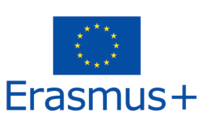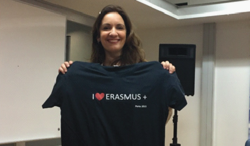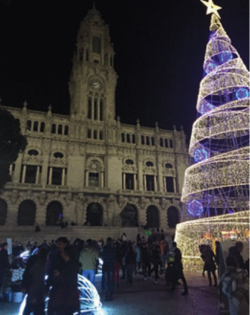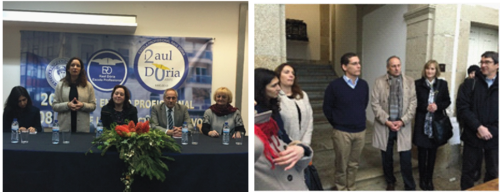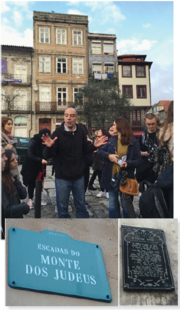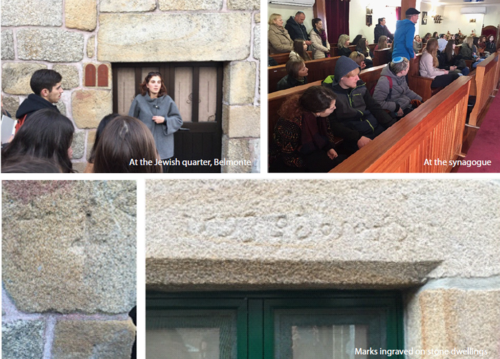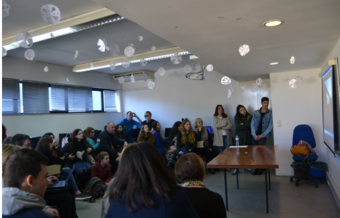Viertes Erasmus+-Treffen in Portugal (Dezember 2015)
|
Das vierte Treffen in Portugal The fourth meeting in Portugal 12/2015
The mobility in Portugal occurred between 07th to 12th December 2015, in Porto. Preparing and planning the week was challenging at different levels, but worth it at the end. All the delegations – teachers and students – were warmly received by the vocational school Raul Dória, represented by the teachers Suzana Melo – project coordinator- and Joana Neto, as well as by the 11 students actively involved in the project “Local Traces of Jewish Culture”. All week long, other Portuguese students volunteered to help with the logistics in many ways to provide the best possible experience at school. Therefore they formed a team ready to assist the visitors in any question they might need help with. The week and its activities were dedicated to the topic of the project, but also to the social and cultural aspects of the Portuguese region.
The week began Sunday evening when all the delegations met at the metro station “Trindade” in the heart of Porto. The students had dinner with their Portuguese partners, and the teachers had dinner together in the old town, where everyone had the opportunity to get into contact with the Christmas atmosphere surrounding the main avenue – Avenida dos Aliados – and walk the old and narrow streets to get to the restaurant situated in front of the rectory of the University of Porto, one of the most iconic city squares – Praça dos Leões - in terms of academic Traditions.
Monday By Monday morning, a welcoming session took place in the auditorium of the school, followed by a work meeting between students and teachers related to the project in order to remember the planning for the week and to agree and define together the last details of the content of the international work group sessions between students. Students liked the idea to produce a video per international group about their experiences of the week. The morning also allowed the visit to the school and moments of sharing ideas with board members and other students. After the coffee break, the whole group had a walk through the old town to reach the Casa Museu Guerra Junqueira, where the city hall culture representative was expecting us. The house-museum is located behind the main cathedral of Porto – Sé -, offering all the visitors a magnificent view at the Ribeira (medieval town along the river) and Douro river, as well as of one of the old Jewish quarters. Guerra Junqueiro was a writer, a poet and more, from Porto, who some historians believe to have Jewish ancestors.
The conference about Jewish routes in Porto and its region was very elucidative and well illustrated by Dr. Manuel Azevedo Graça. The group also had a guided tour to the museum and each visitor received a book from the city hall. After lunch time, at the school auditorium the students from all the delegations presented, , their work about architectural marks of the Jewish presence in their region and country. In the evening, by 7pm, the photographic exhibition about Auschwitz, called “5 olhares” was inaugurated. It showed through white and black photos the five different impressions each delegation had when they visited the Auschwitz camp during the mobility to Poland. The photos were accompanied by excerpts from poems or thoughts of authors - Jews or with Jewish ancestry - from each country involved in the project. The day ended with a welcoming dinner, where the delegations could watch and listen to the performance of two academic groups of Fado from the faculties of Law and Economics of the University of Porto. Each visitor received some typical souvenirs – a mini bottle of Porto wine, the rooster of Barcelos – a Portuguese symbol – and a tile hand painted by our students.
Tuesday was catholic holiday, so it didn´t prevent our visit to the synagogue Kadoorie Mekor.Haim, the biggest one in the Iberian Peninsula. There, we had the possibility to listen carefully to our guide, that explained to us the History of the place and of the Jewish community and its traditions in Porto. Beforet this we had first had a short lecture from Professor Rui Cunha about the German philosopher Hannah Arendt, that allowed everyone to engage in some critical thoughts about humanity, freedom, will and power. It was a productive and mostly meditative moment. The visit ended with the Jewish museum. After lunch, we met the father of one of the Portuguese students, who took the tour guide role to the Jewish quarter. All the afternoon we wandered up and down through the streets of the old Jewish quarter, and found architectural marks in the stones of secular homes, down the vertiginous stairs which gave access to the river and finally through the garden of delights “Jardim dos prazeres”, where centuries before there was an old Jewish cemetery.
Wednesday At 8:30 all delegtions met at the school, to start a walk through the city. We visited many churches, often built in the 18th century, decorated with tiles, Portugal is well- known for, on the outside, carvings and gold in the inside. An interesting church to mention, is the St. Lawrence church (6th century), which had a cemetary right underneath the floor. Also we came by at a famous and beautiful library ( inspiration for the library in the movie “Harry Potter“ ), which was built in the year 1881 and the Clericus Tower with church. Through the little, narrow alleys we reached the St. Louis Bridge with its interesting history. Before the Eiffel Tower was built in Paris, the bridge was the biggest architectural steel construct in the world. There is also a memorial “Souls of the bridge“, dedicated to the victims who once tried to escape from one side when suddenly the bridge collapsed, that happend in earlier days. Afterwards we visited the museum “World of Discoveries“. It replicated the Portuguese discoveries, which began in the 14th century. First, large boats and ships equipped with canons and, were built. Mankind already invented tools for navigation such as the compass. We had an insight of the life on the boats and got the perspective how the globuses looked like back earlier. The Portuguese discovered many areas of the world (e.g. North Africa, Sub-Saharan-Africa, tropical rainforests, India, China, Japan, Brazil) in which they traded and got ordinary treasures such as spices, exotic fruits and animals, alcohol, gold and silver, porcelain etc.
After we visited the university's library, the lecture began with the presentation of the “Erasmus Project“. The pupils were given some historical notes on religious minorities and (in)tolerance. Portugal there was always cultural and religious diversity and the presence of Jewish life. At the end of the 15th century there was a law which said that Jewish people had to live seperately from the Portuguese people, so in specific areas in the town. At some point Jews had to convert to Christianity or otherwise they would have sent away from Portugal. This led to the seperation of the “Old Christians“ and “New Christians“. To re-establish the relationship between Portuguese and the Jews, new laws were passed in the 20th century concerning the protection of religious minorities. The Portuguese Constitution guarantees freedom of conscience, of religion and of form of worship is inviolable, no one may be persecuted or deprived of rights because of his convictions or religious observance. Also we were given a glance at the actual juridicial situation of Jews. The law is friendly and respectful to Jewish minorities and the freedom of religion and marriage (among Jews and Portuguese is ensured. At the end we had a fascinating lecture about the banality of evil including the German philospher Hannah Arendt. Sometimes it is the human's failure to think and the absence of critical thinking, that leads to horrible and inhuman actions of mankind!
The very inspiring day in Belmonte was worth the long trip by bus, which started way too early, at 6 o’clock in the morning. But why is this small city known as “the land of Jews”, although the Jewish community there consists of just 60 Jews nowadays? This decrease is caused by economical problems and a lack of opportunities to work for young people, who therefore emigrate to bigger cities. Another disadvantage is the fact, that someone is only a Jew if his mother is Jewish. But many Jewish men married Christian women. The very sympathetic woman who guided us through Belmonte explained that as a consequence the future of the local Jewish community is very uncertain. Well, back to the question, whose answer will be found in the past. During the time of Inquisition and persecution in Portugal, crypto Jews could live there in secret. These Jews pretended to be New Christians, who converted to Christianity, but in fact they still practiced their Jewish habits, traditions and prayers in secret. By definition Crypto-Judaism is the secret adherence to Judaism while publicly professing to be of another faith; practitioners are referred to as "crypto-Jews" (origin from Greek kryptos - κρυπτός, 'hidden'). The term crypto-Jew is also used to describe descendants of Jews who maintain some Jewish traditions of their ancestors while publicly adhering to other faiths. Crypto-Jews could hide their belief for five centuries in Belmonte. What is very fascinating. Moreover, it was very interesting, that the houses of the Jews were marked. It’s said on the one hand side, that they were marked by the Christian officials, to be sure, that New Christians live in those houses. On the other hand side, researcher try to find evidence that the Jews wanted to give messages to other Jews this way. We visited the small and very beautiful synagogue in Belmonte. The Rabi gave us some further information. He told us about his plan to bring non-Jewish students with Jewish routes in touch with the Jewish belief. Maybe even to win them over to Judaism. Furthermore, we visited the Museu Judaico de Belmonte, which is the biggest museum about Jewish society in Portugal. The Jewish Museum of Belmonte is aimed to become a unity of documentation, investigation, exposition and divulgation about the role played by the local Jewish community within the Jewish history and culture, to whom, this way the city council pays reverence. After many information we were glad to have lunch at a restaurant. To talk, relax and prepare for the long bus drive back to Porto. Anna-Lena Hahn
Freitag On Friday, the morning was spent at school. All the students had the opportunity to integrate in classes, where Portuguese teachers and students prepared study activities related to the subject of the lesson. Meanwhile, teachers were having their final meeting to evaluate the week and prepare the next mobility. The day was also dedicated to the presentation of the final works of each group: the group videos. The results were positive and different, ranging from humorous nature videos to other more journalistic versions of a summary of the week in Porto. After a lunch together in a typical restaurant along Douro river, the group took a boat ride, discovering the magnificent scenery of the Old Town and learning a little more about its history and its bridges. In the evening, teachers and students had their goodbye dinner and left Porto on the next day.
|
